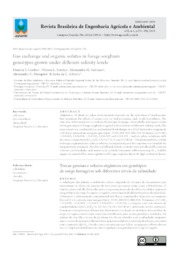Gas exchange and organic solutes in forage sorghum genotypes grown under different salinity levels.
Gas exchange and organic solutes in forage sorghum genotypes grown under different salinity levels.
Author(s): COELHO, D. S.; SIMOES, W. L.; SALVIANO, A. M.; MESQUITA, A. C.; ALBERTO, K. da C.
Summary: Adaptation of plants to saline environments depends on the activation of mechanisms that minimize the effects of excess ions on vital processes, such as photosynthesis. The objective of this study was to evaluate the leaf gas exchange, chlorophyll, and organic solute in ten genotypes of forage sorghum irrigated with solutions of different salinity levels. The experiment was conducted in a randomized block design, in a 10 x 6 factorial arrangement, with three replications, using ten genotypes - F305, BRS-655, BRS-610, Volumax, 1.015.045, 1.016.005, 1.016.009, 1.016.013, 1.016.015 and 1.016.031 - and six saline solutions, with electrical conductivity (ECw) of 0, 2.5, 5.0, 7.5, 10 and 12.5 dS m-1. The photosynthetic activity in forage sorghum plants reduces with increasing salinity, and this response was found in the ten genotypes evaluated. The chlorophyll and protein contents were not affected by salinity, whereas carbohydrates and amino acid contents increased with increasing EC w. Soluble sugars are essential for osmoregulation of forage sorghum due to its high content in leaves.
Publication year: 2018
Types of publication: Journal article
Unit: Embrapa Semi-arid Region
Observation
Some of Embrapa's publications are published as ePub files. To read them, use or download one of the following free software options to your computer or mobile device. Android: Google Play Books; IOS: iBooks; Windows and Linux: Calibre.
Access other publications
Access the Agricultural Research Database (BDPA) to consult Embrapa's full library collection and records.
Visit Embrapa Bookstore to purchase books and other publications sold by Embrapa.

